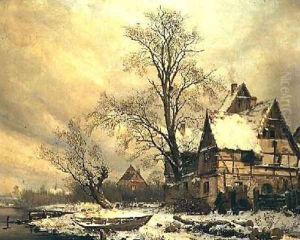Karl Julius Von Leypold Paintings
Karl Julius von Leypold was a German painter, born on May 23, 1805, in Dresden, Saxony. He is recognized for his contributions to German Romanticism, a movement that emphasized emotion and individualism, a departure from the classical traditions that preceded it. Leypold's works are characterized by their detailed landscape paintings, which often featured the sublime beauty of nature, a common theme in Romantic art. His ability to capture the ephemeral qualities of light and atmosphere in his landscapes has been highly praised.
Leypold received his artistic training at the Dresden Academy of Fine Arts, where he was influenced by Caspar David Friedrich, one of the leading figures in German Romanticism. Although Friedrich's influence is evident in Leypold's emphasis on the emotional and spiritual aspects of nature, Leypold developed his own distinctive style, marked by a meticulous attention to detail and a profound appreciation for the natural world. Throughout his career, he traveled extensively across Europe, drawing inspiration from the diverse landscapes he encountered. These journeys allowed him to expand his repertoire and refine his technique, contributing to the depth and diversity of his work.
Despite his talent and contributions to the art world, Leypold did not gain the same level of fame as some of his contemporaries during his lifetime. However, his works have been reassessed in recent years, and he is now recognized as an important figure in the Romantic movement. His paintings are celebrated for their technical skill, emotional depth, and the artist's keen observation of nature. Leypold's legacy is preserved in the collections of various museums and galleries across Germany and beyond, offering insight into the Romantic spirit and its enduring impact on the world of art.
Karl Julius von Leypold died on August 17, 1874, in Dresden. His death marked the loss of a significant but underappreciated talent from the Romantic era. Today, his contributions to the movement are more widely acknowledged, and he is celebrated as a master of landscape painting, whose works continue to inspire admiration and scholarly interest for their beauty, complexity, and emotional resonance.
